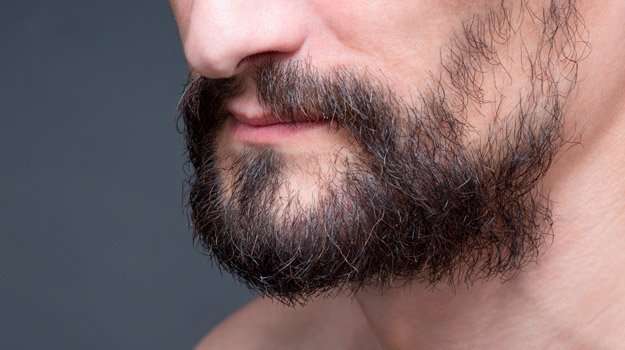If you notice bald spots in your beard, you may have a condition called alopecia barbae. Alopecia barbae is a common hair loss condition that may occur in small to large patches, and in rare cases, the whole beard. Here we answer the most common questions about alopecia barbae and how to manage its symptoms.
RELATED: 5 Ways To Deal With Receding Hairline In Men
Bald Spots and Patchy Beards: Alopecia Barbae Explained
What is Alopecia Barbae

Alopecia barbae is a specific form of alopecia areata. It is an autoimmune disorder in which the inflammatory cells mistakenly attack their cells. In this case, the cells in the hair follicles.
Alopecia barbae causes patches and bald spots on the beard area. It is also known as the alopecia areata of the beard (BAA). Dermoscopic features of BAA include yellow dots, broken hair, and short and thin light-colored hairs.
What are the symptoms of Alopecia Barbae?
The most common symptom of alopecia barbae is hair loss. However, you may also notice the following:
- Small bald patches
- Inflammation in the hair follicles
- Hair loss over a short time
- Itchy and or tingling sensation before the hair falls out
- Hair grows back in one spot and falls out in another
The bald spots are often smooth with no redness. However, over time, the small patches may get larger or grow together into a bald spot.
What Causes Alopecia Babae?
The exact causes of alopecia are unknown. However, some people are more likely to get it. Historically, physical and psychological stress was considered a factor in its development.
Genetics may also play a role as a risk factor in acquiring autoimmune diseases. For instance, having relatives with an autoimmune condition puts you at a higher risk of developing the same disorder. Alopecia is also common for people who have relatives with asthma and allergies.
How Common is Alopecia?
Alopecia is a common autoimmune skin disease that affects 6.8 million people in the U.S. alone.
According to the American Hair Loss Association, 2 out of 100 people will get alopecia areata later in their lives. Approximately 60% of people under 20 experience the first incident of hair loss due to alopecia areata.
RELATED: Growing A Healthy Head Of Hair: Biohacks, Hormones & Hair Peptide Therapy
What are the Treatments for Alopecia Barbae?
There are no known treatments for autoimmune diseases. However, there are several ways to manage its symptoms.
Diagnosis
To diagnose your condition, a doctor or dermatologist will look at your hair loss and hair samples under a microscope.
To check if you have underlying medical conditions, you may need to have a blood test to test for signs of an infection.
Treatment Options
Medications
A range of medications can treat hair loss on your beard area, including:
- Corticosteroid. Corticosteroid comes in topical creams or injections applied to the bald patches.
- Minoxidil (Rogaine). Minoxidil is a common topical drug prescribed by doctors to treat hair loss problems.
diphencyprone (DPCP). This medication helps stimulate hair growth in advanced alopecia areata. - Anthralin. Anthralin topical cream or ointment can help control inflammation at the base of the hair follicle. It can also treat psoriasis.
The result of a study suggests that combination therapy of diphencyprone and anthralin can result in higher efficacy in beard, eyelashes, and eyebrows regrowth.
Hair Peptide Therapy
Peptides are smaller and more broken down than proteins making it easier for these amino acids to enter the bloodstream more quickly. These short strings of amino acids can help produce elastin and collagen responsible for healthy hair and smooth and firm skin.
Studies in rats and humans have shown significant hair regrowth. Hair peptide therapy may help reverse hair loss and increase hair growth within the course of treatment.
Here at YM, we utilize cutting-edge technology to solve hair-loss problems using peptides. For hair loss concerns, we use copper peptides or GHK-CU, a regenerative peptide that enhances hair growth. We also have ThYuniqueus Peptide, an effective solution for chronic hair loss conditions.
Hair loss in the facial area, such as alopecia barbae, may cause distress in most people. In some cases, alopecia is not permanent. With the advent of modern science, you can choose the most effective treatment to manage its symptoms.
Are you looking for effective ways to manage bald spots and thinning hair? Contact us today to see how we can help you with hair-related concerns! We have offices located in Ocala, Florida, as well as Fruitland Park and Daytona.
UP NEXT:
- Biohacking: Improve Your Well-being With Simple Health? Hacks?
- From Creams To Pellets: How Does Bioidentical Hormone Replacement Therapy Work?
- Are You Aging on a Cellular Level? Cutting Edge Peptide Therapy May Soon Be Able To Help With That.

